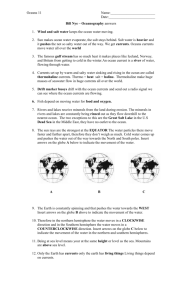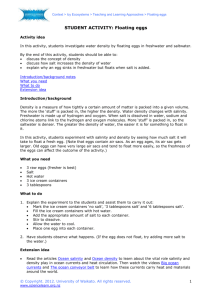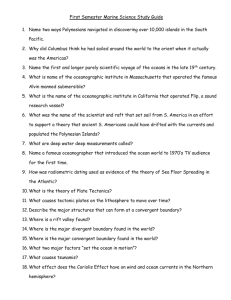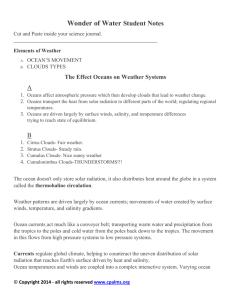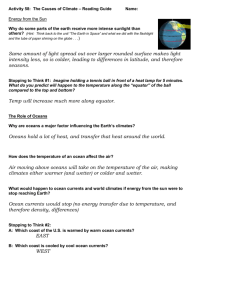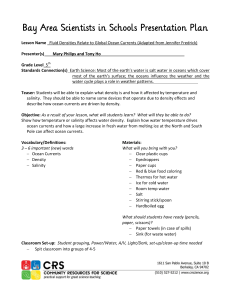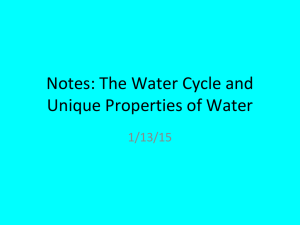Density Matters
advertisement
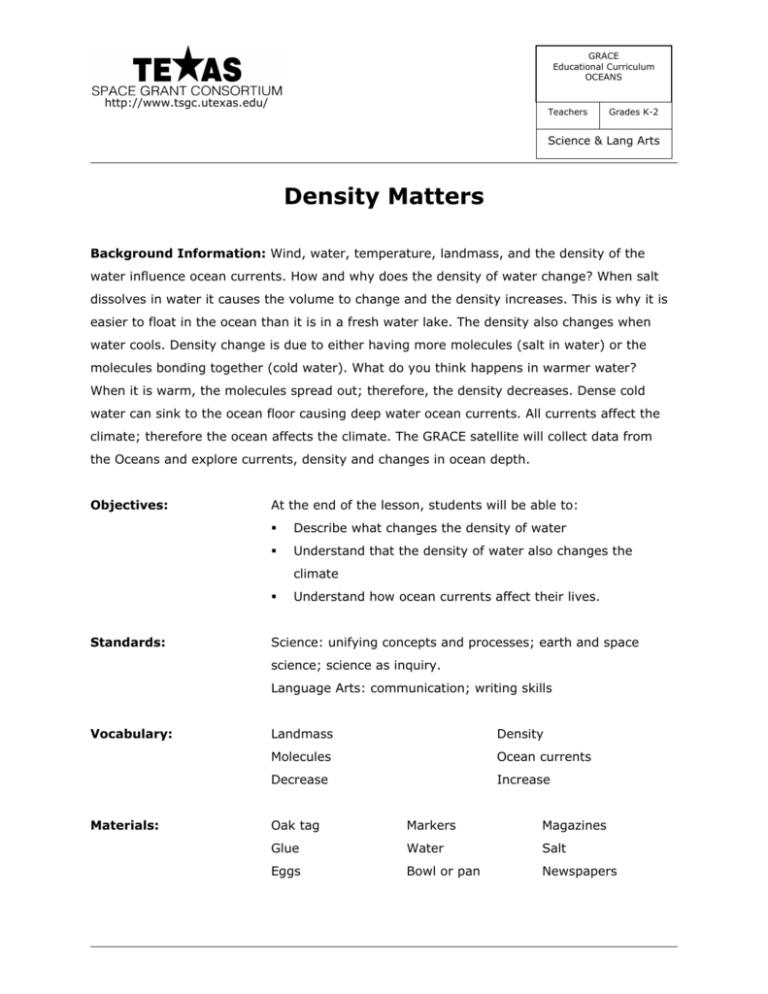
GRACE Educational Curriculum OCEANS http://www.tsgc.utexas.edu/ Teachers Grades K-2 Science & Lang Arts Density Matters Background Information: Wind, water, temperature, landmass, and the density of the water influence ocean currents. How and why does the density of water change? When salt dissolves in water it causes the volume to change and the density increases. This is why it is easier to float in the ocean than it is in a fresh water lake. The density also changes when water cools. Density change is due to either having more molecules (salt in water) or the molecules bonding together (cold water). What do you think happens in warmer water? When it is warm, the molecules spread out; therefore, the density decreases. Dense cold water can sink to the ocean floor causing deep water ocean currents. All currents affect the climate; therefore the ocean affects the climate. The GRACE satellite will collect data from the Oceans and explore currents, density and changes in ocean depth. Objectives: At the end of the lesson, students will be able to: ß Describe what changes the density of water ß Understand that the density of water also changes the climate ß Standards: Understand how ocean currents affect their lives. Science: unifying concepts and processes; earth and space science; science as inquiry. Language Arts: communication; writing skills Vocabulary: Materials: Landmass Density Molecules Ocean currents Decrease Increase Oak tag Markers Magazines Glue Water Salt Eggs Bowl or pan Newspapers Directions to the Teacher: 1. Review the background information on currents and density. Define density. 2. Explain to students that we will change density. The experiment may be performed as a class demonstration or have students work in pairs or in small groups. 3. Distribute or set up the ingredients and materials needed. 4. Have students fill the bowl with tap water and put the egg in the water. Does the egg float or sink? Why? Write the results on chalkboard or have students write the results in their lab journals depending on age. 5. Now take the egg out and add _ cup of salt to the water. Make sure the salt has dissolved in the water. Ask students what they think will happen when the egg is placed in the salt water compared to water with no salt? 6. Place the egg in the salt water. Does it sink or float? Record your answers and discuss. 7. By adding the salt, the students changed the water density. 8. For the language arts extension activity have students get supplies out (markers, glue, magazines, newspaper, oak tag). Explain to students that they will draw a picture, write words, a sentence or paragraph, depending on the age group and ability levels, to describe: How density affects us in our lives? 9. After the students have written their assignment, they can draw or cut out magazine pictures that show how density affects us. Students can make one large picture, many pictures or a collage to attach to their writing assignment. Remind students that density affects ocean currents, which affect the climate or weather. Students should be able to find pictures of oceans, weather etc. Extensions: • Look at a global map with oceans. Where is the temperature warm? Where is it cool? Where do you think the oceans are dense? • How does weather affect a farmer’s crops? • If two cans of soda were placed in a cooler with icy water and one was regular soda and one diet, which one would float to the top and which one would sink to the bottom? The regular soda would be on the bottom because it has more sugar (more dense). References / Resources: Jenkins, Steve Hottest, Coldest, Highest, Deepest. Houghton-Mifflin:NY. http://www.umassd.edu/Public/People/Kamaral/thesis/ElNino.html http://www.tidepool.org/derek/greencrab.html http://mbgnet.mobot.org/salt/oceans/indexfr.htm http://www.weatherchannel.com http://www.discovery.com http://seawifs.gsfc.nasa.gov/OCEAN PLANET/HTML/ http://www.oceanplanetoverview.html


